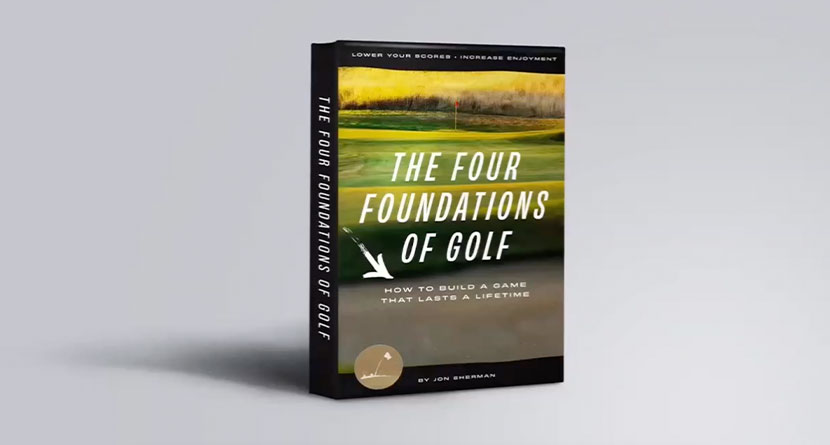The following is an excerpt from Jon Sherman’s The Four Foundations of Golf, a complete guide to golf that a player of any level can use to lower their scores and increase their enjoyment of the game.
This excerpt comes from Part One of Jon’s Book: MANAGING EXPECTATIONS.
Most golfers are avid viewers of professional golf on TV. While watching the best players in the world can be very entertaining, it often does a great disservice to golfers to manage their expectations appropriately. In this chapter, I want to clarify a few things about the professional ranks and how it pertains to your game.
There Isn’t Much To Learn From Them
The golf industry has done a great job marketing itself through PGA Tour players. Growing up, I voraciously read the top magazines to figure out how to improve my game. The same formula has been used for decades. All they do is pick the best players and write catchy headlines like the following:
“Find out Dustin Johnson’s 5 Keys to Power”
“Want to Putt Like Brandt Snedecker?”
For the most part, it’s the same content over and over again. There isn’t much substance in the articles, and week after week, you are being given new information without giving yourself the proper amount of time to work on the last swing tip. It’s a vicious cycle that usually does not lead to success.
The best golfers in the world can do things with their bodies that recreational golfers cannot. You’d likely get hurt if you tried to make the same shoulder turn as Dustin Johnson! They have spent their whole lives preparing, have immense natural talent, and it’s their job to practice and play almost every day. The rest of us are playing an entirely different game. So if someone tells you to recreate a move in Rory McIlroy’s swing, I would suggest looking in the opposite direction.
The interesting part is that as good as the pros are, golf can be just as difficult and perplexing to them as it can be to the rest of us. Of course, it’s on a different level, but they’re not as good as you think!
What You See Is Misleading
Television broadcasts are one of the main reasons golfers have unrealistic expectations. The network’s primary goal is to keep you tuned in and to do that, they need to entertain you. Do you think that will happen by showing you shots of golfers you never heard of shooting a 76 and missing the cut? Probably not.
For the most part, golf on TV is a highlight reel. In the earlier rounds, they are cycling back and forth between massive drives, approach shots landing near the pin, and 25 footers dropping for birdie. There are usually close to 150 golfers playing, but you’re being shown the most impressive performances from the biggest names. When it gets down to the weekend, they will focus on the players who are all playing the best that week.
So what happens when all of us watch these broadcasts repeatedly for years? We start to subconsciously view the game through a lens that is not realistic. I have seen golfers throw tantrums because they couldn’t land the ball next to the pin from 100 yards out. Others will curse themselves for missing a 12-footer. Most of these outcomes are very reasonable for their skill level and even the pros, but it doesn’t stop them from getting upset.
Don’t get me wrong; the pros are genuinely incredible at golf. But I would like to share a few statistics that just might surprise you and hopefully get your mind in a better place on the course.
Four Stats That Should Provide Relief
My main goal in this section of the book is to remove a burden off your shoulders. I played the game for too long expecting way too much of myself, and I know it hindered my ability to enjoy myself and improve.
When it comes to PGA Tour stats, many of them are not relevant to ordinary golfers. The length of their drives, fairways hit, greens in regulation, and many of the other traditional stats are not helpful to your progress. However, there are a few numbers that I always like to remind people that can be very powerful. I’ll revisit many of these later in the book in the strategy section and how you can use this information to make smarter decisions that will lower your scores.
The Green Light
One saying you’ve heard over and over again is that a golfer has the “green light” to go after the pin when they’re in the fairway with a wedge in their hand. I am willing to wager a large amount of money that if I polled golfers and asked them how close, on average, a PGA Tour player can land the ball to the pin from 100-125 yards, they would get the answer wrong by a significant margin.
Over the past several years, the best player on tour from 100-125 yards was landing the ball just over 15 feet from the pin on average. The median was roughly 20 feet, and the worst performer was somewhere around 26-28 feet.
Think about that for a moment. The best golfers in the world cannot even come close to landing the ball within 10 feet of the hole on average. A lot of this has to do with strategy, but the fact of the matter is that landing the ball on the green from that distance should be a reasonable goal that most golfers should celebrate. If you give yourself a 20-foot look for birdies, then know you are keeping pace with the best of the best.
Additionally, this statistic has significance for all approach shots and what golfers should consider a “good shot.”
Recovery Situations
PGA Tour players make bogey roughly 80% of the time in recovery situations, such as being in the trees. Of course, it seems like every time we see these shots on TV there is a miraculous outcome.
This is one of the most interesting statistics discussed in Mark Broadie’s book Every Shot Counts. When most golfers hit an errant tee shot, their instinct is to get aggressive and try threading the ball through a small opening. Alas, it usually compounds the initial mistake and results in a double bogey or worse, which is one of the main reasons most players struggle to lower their scores.
If you make bogey from that situation, you’ll be matching the performance of most PGA Tour players. I can’t stress this statistic enough; please remember it when you’re on the course.
Putting Is Hard for Everyone
I’ve always thought of putting as a different game within golf. Most golfers measure their success by a binary standard – the ball went in the cup or it didn’t. Missing a putt of any length is usually met with disappointment. When you start to examine the statistics behind putting, and see what kind of odds golfers have at sinking putts from different distances, usually there is an element of surprise.
View this post on Instagram
The most eye-opening statistic for most is that from 8 feet, a tour pro only has a 50% chance of making the putt. Once they get outside that distance, their chances of holing out drop dramatically.
For now, try to internalize these numbers. I will discuss how you can use them to practice more effectively and how to improve your putting in later chapters.
Birdie Machines? Hardly Not!
If you didn’t know, birdies are very hard to come by. Probably much harder than you think.
The best players on the PGA Tour typically average around 4.5 birdies per round, which is truly exceptional. The median on tour is about 3.5 birdies per round, and the last place can be anywhere from 2.5 to 3.
Additionally, most of those birdies are coming from Par 5s. Here is the PGA Tour scoring average for 2021 by hole:
Par 3: 3.08
Par 4: 4.05
Par 5: 4.63
It is very unrealistic for golfers looking to break 100, 90, or 80 to make many birdies. The real key to reaching those milestones is mostly avoiding big numbers. Choosing aggressive strategies to make more birdies will only push you further away from your scoring goals.
Remember These Stats on the Course
Golf is a challenging game, whether you are a club player or trying to be the best in the world.
Time and time again, I have seen golfers beat themselves up on the course (myself included) for hitting shots that were quite good for their skill level. When your mood sours like this, it affects your mental ability to stay in the round. If you can adjust your expectations appropriately, it will save you strokes in the long run.
Keep these stats in mind and think about them during your rounds. Properly managing expectations is one of the greatest tools a golfer can have.
The Big Ideas
- Professional golfers are playing an entirely different game. Be careful assuming you have much to learn from them whenever you watch television broadcasts or read articles about their swing tips!
- TV is mostly a highlight reel of the best shots at any time. If they exclusively showed tour players at the bottom of the leaderboards missing cuts, you’d see a very different version of golf.
- A typical tour player will hit the ball about 20 feet from the hole with a full wedge shot in the fairway. This is an essential reference point for multiple reasons.
- A PGA Tour player will make bogey roughly 80% of the time in a recovery situation like being in the trees. Stop trying to be a hero!
- Putting is perhaps the most difficult and misunderstood part of golf. Golfers have their best chance of holing putts inside of 8 feet, and outside of those distances, it becomes more of a test of speed control and proximity.
- Birdies are very hard to come by, even for tour players. Lowering your scores is not about making more birdies; it’s more about mistake avoidance.





